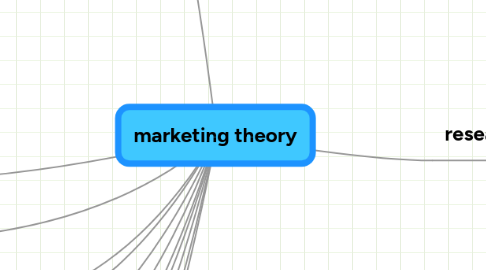
1. literature
1.1. brochures
1.2. newsletters
2. campaigns
2.1. advertising
2.1.1. printed
2.1.2. broadcasting
2.1.3. direct
2.1.3.1. printed
2.1.3.2. email
2.1.4. on business material
2.2. promotions
2.2.1. trade shows
2.2.2. cross promotion
2.2.3. co-operative
2.3. pr
2.3.1. relations
2.3.1.1. media
2.3.1.1.1. news releases
2.3.1.2. employee
2.3.1.3. community
2.3.1.4. industry
2.3.1.5. government
2.3.2. housekeeping
2.3.2.1. issues management
2.3.2.2. crises management
3. naming
3.1. company
3.1.1. ideas
3.1.1.1. what to convey
3.1.1.2. available
3.1.1.3. easy
3.1.1.3.1. to spell
3.1.1.3.2. to say
3.1.1.4. original
3.1.1.5. universal
3.1.1.6. memorable
3.1.1.7. can I live and grow?
4. channels
4.1. phone
4.1.1. pick-up
4.1.2. voicemail
4.2. face-to-face
4.2.1. parking
4.2.2. front door
4.2.3. office
4.2.3.1. reception
4.2.3.2. desk space
4.2.3.3. meeting room
4.3. online
4.3.1. website
4.3.1.1. themes
4.3.1.1.1. scratch area
4.3.1.1.2. some freebies
4.3.1.1.3. tools
4.3.1.1.4. no left-hand navigation
4.3.1.2. phases
4.3.1.2.1. phase 1
4.3.1.2.2. phase 2
4.3.1.2.3. phase 3
4.3.2. email
4.3.2.1. incoming
4.3.2.1.1. response times
4.3.2.2. outgoing
4.3.2.2.1. tone
4.3.2.2.2. greeting
4.3.2.2.3. signature
5. customer service
5.1. services
5.2. service
5.2.1. cycle
5.2.1.1. establish contact
5.2.1.2. build rapport
5.2.1.3. present service
5.2.1.4. make sale
5.2.1.5. complete transaction
5.2.1.6. deliver service
5.2.1.7. monitor customer satisfaction
5.2.1.8. follow-up after sale
5.2.1.8.1. assess
5.2.1.8.2. confirm
5.2.1.8.3. ask for future business
5.2.2. benchmarking
5.2.3. improving
5.2.3.1. make gaurantee
5.2.3.2. note and overcome dissatisfaction
5.2.3.3. think every step improve customer
5.2.3.4. evaluate service
5.2.4. customer service environment
5.2.4.1. get to know them
5.2.4.2. reward good service
5.2.4.3. anticipate
5.2.4.4. communicate
5.2.4.5. thank customers
5.2.4.6. encourage requests
5.2.4.7. bend rules
5.2.4.8. extra services
5.2.4.9. dealing with BKJ highlight of their day!
5.2.4.10. teach customers to expect good service
5.3. types of customers
5.3.1. best
5.3.2. relationship
5.3.2.1. loyalty
5.3.2.2. commitment
5.3.3. transaction
5.3.3.1. price
5.3.4. toxic
5.4. referral
6. sales
6.1. stages
6.1.1. preparation
6.1.1.1. knowledge
6.1.1.1.1. service
6.1.1.1.2. prospect
6.1.1.1.3. your sales goal
6.1.1.2. presentation
6.1.2. awareness
6.1.2.1. gain positive awareness
6.1.3. interest
6.1.3.1. generate interest
6.1.4. desire
6.1.4.1. convey value
6.1.5. decision
6.1.5.1. understand the cycle
6.1.5.2. who are decision makers
6.1.6. sale!
6.2. funnel
6.3. aims
6.3.1. exceed customer value expecations
6.3.2. loyalty
6.3.3. trust
6.3.4. make it easy
6.3.4.1. ready made contract
6.3.4.2. add unexpected value
6.3.4.3. make first step of loyalty
6.4. scenarios
6.4.1. walk-in
6.4.2. cold calls
6.4.2.1. use of reference
6.4.2.2. convey customer benefit
6.4.2.3. assumptive approach
6.4.3. letters
6.4.4. presenting product
6.4.4.1. describe service
6.4.4.1.1. benefits features
6.4.4.1.2. solve problems
6.4.4.1.3. provide opportunities
6.4.4.2. a few major points
6.4.4.2.1. can relate to
6.4.4.2.2. and remember
6.4.4.3. entertaining
6.4.4.4. ask, then listen
6.4.4.5. show, don't tell
6.4.4.6. pre-empt objections
6.4.4.6.1. lack of belief
6.4.4.6.2. lack of trust
6.4.4.6.3. preference to competitor
6.4.4.6.4. concern over cost
6.5. stages
6.5.1. selling
6.5.2. prospect ready to buy
6.5.2.1. ask for the order
6.5.2.2. ask for the order
6.5.2.3. ask for the order
6.5.2.4. make buying assumption
6.5.2.5. gain agreement how delivered
6.5.2.5.1. schedule
7. distribution
7.1. online
7.2. hard copy
7.2.1. EPS printing
8. product development
8.1. new products to new customers
8.2. existing products to new customers
8.3. new products to existing customers
8.4. existing products to existing customers
9. putting together a communication
9.1. define goal
9.2. creative brief
9.3. benefits not features
9.4. success criteria
9.5. budget
10. budget
10.1. arbituary
10.2. competitive parity
10.3. goal-oriented
10.4. %sales
11. ten ideas
11.1. best
11.1.1. know your elevator speech
11.1.2. make great product before great ad
11.1.3. sweat the big stuff- ad headline
11.1.4. sweat the little stuff- the detail
11.1.5. say what you mean
11.1.5.1. believe in your service
11.1.6. make new customers, cherish the old
11.1.7. like your customers
11.1.8. increase value before lowering prices
11.1.9. breakdown barriers
11.1.10. get continously better at what you do best
11.2. worst
11.2.1. fight bad business with good ads
11.2.2. run kitchen sink ads
11.2.3. portray customer as fool
11.2.4. save best for last
11.2.5. change logo too often
11.2.6. build it and trust they will come
11.2.7. move too fast without plan
11.2.8. think people will care 'under new management'
11.2.9. believe pie in online sky
11.2.10. believe customer is captive
12. products
12.1. creative strategy
12.1.1. target market
12.1.2. benefit to the market
12.1.3. how present identity to market
12.2. marketing plan
12.2.1. state business purpose
12.2.2. define market situation
12.2.3. set goals and objectives
12.2.4. define your market
12.2.5. advance your position, brand and creative strategy
12.2.6. set your marketing strategies
12.2.6.1. product
12.2.6.2. distribution
12.2.6.3. pricing
12.2.6.4. promotion
12.2.7. outline your tactics
12.2.8. establish your budget
12.2.9. blueprint your action plan
12.2.10. think long term
12.2.11. use your plan!
13. research
13.1. customer
13.1.1. type
13.1.1.1. size
13.1.1.2. history
13.1.1.2.1. consultancy experience
13.1.1.3. sector
13.1.1.3.1. private
13.1.1.3.2. public
13.1.1.4. the 'ics
13.1.1.4.1. demographic
13.1.1.4.2. geographic
13.1.1.4.3. psychographic
13.1.1.4.4. geodemographics
13.1.1.5. key people
13.1.1.5.1. ownership
13.1.1.5.2. decision makers
13.1.2. trigger
13.1.2.1. right-sizing
13.1.2.1.1. reducing
13.1.2.1.2. growing
13.1.2.2. replacing in-house teams
13.1.2.3. acquisitions
13.1.2.4. control costs
13.1.2.5. mergers
13.1.2.6. maturity model
13.1.2.7. setting-up
13.1.2.8. new starter/induction
13.1.2.9. material for comms
13.1.2.10. new IT
13.1.2.10.1. already procured
13.1.2.10.2. to be procured
13.1.3. behaviour
13.1.3.1. habits
13.1.3.1.1. business analysis
13.1.3.1.2. mission statement
13.1.3.1.3. flowcharting
13.1.3.1.4. process maps
13.1.3.1.5. transformation
13.1.3.2. mindsets
13.1.4. prioritise
13.1.5. timing
13.2. products
13.2.1. new ideas
13.2.1.1. features
13.2.1.1.1. inspire
13.2.1.1.2. value
13.2.1.2. fit
13.2.1.2.1. brand
13.2.1.2.2. expertise
13.2.1.2.3. market
13.3. competitors
13.3.1. types
13.3.1.1. consultancies
13.3.1.1.1. business analysis
13.3.1.1.2. project management
13.3.1.1.3. management
13.3.1.2. in-house teams
13.3.1.3. freelance resources
13.3.2. basis of competition
13.3.2.1. price
13.3.2.2. not-price
13.3.2.2.1. quality
13.3.2.2.2. prestige
13.3.2.2.3. service
13.3.2.2.4. repututation
13.3.2.2.5. location
13.3.2.2.6. uniqueness of offering
13.3.2.2.7. convenience
13.3.3. SWOT analysis
13.4. market
13.4.1. types
13.4.1.1. consultancy
13.4.1.1.1. transformation
13.4.1.1.2. internal comms
13.4.1.2. product templates
13.4.1.3. training
13.4.1.4. facilitation
13.4.2. size
13.4.2.1. by geographic
13.4.2.2. by customer profile
13.4.2.3. by product sales
13.4.3. share
13.4.3.1. sales
13.4.3.1.1. unit sales
13.4.3.1.2. total sales volume
13.4.3.2. customer
13.4.3.2.1. potential customers
13.4.3.3. opportunity
13.4.4. trends
13.4.4.1. increasing
13.4.4.2. decreasing
13.4.5. cycle
